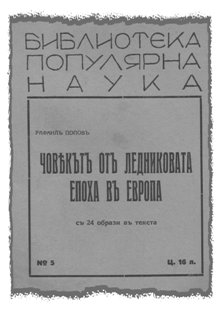
MAN OF THE ICE AGE
Author: Rafail Popov

There are several key-points that should be elucidated on this specific topic. Complementary reading on prehistoric archaeology can be also found in "Dimitrov, D. Introduction to Archaeology. Sofia, 1958" and "Mikov, V. Guide to the Archaeology Museum. Sofia, 1952" from the booklist. Here we should expand further on the personality and lifetime of Prof. Rafail Popov.
The stature of this man and scholar stands high in the circles of Bulgarian science and culture. Yet he always seems to be like the figure of the "hurrying rabbit", described so brilliantly by the logician Lewis Carol in his "Alice in Wonderland". He always strive to explain too much things in a too short time and that makes him inadequate. But time is long and life is short. Thus R. Popov wrote much in the field of archaeology and left much to be explained by his followers.
Another demise from his lifetime was the epoch in which he lived and worked. At the beginning of the 20th century scholasticism was as strong as ever, notwithstanding, as destructive towards progress as physical warfare on the community of life. Thus animal ancestry of man was ardently rebuked by the church and teaching in schools and universities was vividly censored by governmental programs. Eventually, much evidence on the prehistory of man was discarded from scientific circulation which postponed general conclusions on antiquity for 20-30 years later. So was with R. Popov, who had been evidently well acquainted with archaeological discoveries of old human remains — viz., Neanderthal man, Java man, Heidelberg man and even Proconsul man. This doesn't prevent him to deploy a particular classificatory scheme that combined old-fashioned geological timing (diluvium-alluvium chronology) with modern (topographic location) archaeological terminology.
Debated are also his observations on evolution and variation. These could be explained best with comparing the cases of the horse and the man. From standpoint of evolution the two species have similar development and fit elegantly as evolutionary forms of simple to complicated into-as-much "survival of the fittest" organism. However, the theme of variation is a failure for the horse and the man. The mandatory jump from one branch of the evolution tree to another branch lacks substantial argumentation. It is not because R. Popov didn't have knowledge in molecular biology, but because hiatuses in the life-picture were too many so as an ape-man mutagenesis couldn't be recognized.
On the professionalism of the titular not much could be said — viz., explanatory value of his knowledge on such phenomenon as "glaciations", "fossilization", "stratification", etc. are limited. Moreover, the bulgarian language doesn't offer an apparatus nor long enough tradition to comprehend complex ideas in such a short time period. Yet R. Popov tried to give an initial picture on the "antiquity of man" in several well written monographs and numerous short articles. His best work remains "Culture and Life of the Prehistoric Man in Bulgaria", two volumes, that is singularly a guide on Paleolithic and Neolithic research in Bulgaria.
The article from this short review is taken from international literature and contains material that refers to locations worldwide in Europe, Asia and America. While it is difficult to systematize comparable sites (caves, tumuli, etc.) and artifacts (stones, bones, etc.) for the case of Bulgaria — subsequently, in the course of the next 50-100 years and in the 21st century the dawn of civilization on this lands could be explained, ditto.
Pictures 1 & 2: Rafail Popov was student of the German pre-history school of Prof. Gustav Kosinna and Prof. Hubert Schmidt. His geological timing scale was deployed firstly by Englishmen and was an allusion from the Flood in the Biblical Genesis (cf., authorities in natural theology like William Buckland and William "Strata" Smith).
|
(i). Prof. Rafail Popov (1876-1940).
|
|
(ii). Old-fashioned geological timing (Diluvium-Alluvium chronology) deployed from natural theology.
|
Copyright © 2009 by the author.